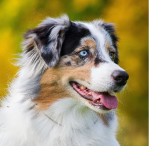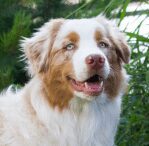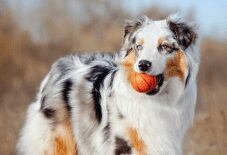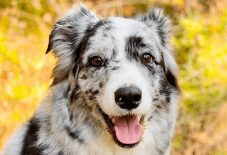
Meet the Australian Shepherd
High Doggy I.Q.
Top Working Dog
Best Fur Friend
Looking for a highly trainable, super smart dog who is eager to please and loves to be put to work? Then you may just be the human for me! Whether it’s rounding up cattle or the kids for breakfast, learning wag-worthy tricks or how to be the best guide dog ever, I’m happiest when I have a job to do. It’s probably why I’m so into sports, and can fetch a flyball like it’s my job. And that’s not all!
I’m a loyal, loving family dog, who with a little training, can be a great playmate for kids and other pets (it may take me a hot sec with that feline that’s all RAWR! though). Just one thing! As a herding dog, I need lots of exercise and play to live my best life – bored Aussies can get a little bit naughty. But if you put in the work, I promise to make you happy every day that you did.
Ready to learn more about me? Let’s dig in.
Ready to learn more about me? Let’s dig in.
 My Many Looks
My Many Looks

Black Tri

Blue Merle

Red Tri

Red Merle
 My Breed Characteristics
My Breed Characteristics
 Furbulous Fact
Furbulous Fact
Did you know that it’s common for Australian Shepherds to have two different colored eyes AKA a condition called heterochromia? Yep, we’re one of only a few breeds to claim this pawesome feature as our own. Possible eye color combos vary, and may include blue, brown, amber, hazel, and green!
 As I Grow Up
As I Grow Up
As you can see, we Aussies age pretty gracefully. Here are a few key milestones in my growth & development to be aware of as I grow up from a pupper to an adult and senior!

Puppy4 Months
I’m ready for socialization classes & obedience training! (Just make sure I’ve had all my vaccines first, pawlease)!

Adult1.5 Years
I’m officially an adult AKA “mentally mature,” with the brainpower to outsmart many animals, including my human.

Senior9-10 Years
I’m over 60 in human years! Help me stay at the top of my game by scheduling vet check-ups every 6 months.
 History of My Breed
History of My Breed
Contrary to popular belief, my ancestors did not come from Australia. They actually came from the Pyrenees Mountains on the border of France and Spain AKA Basque country. Known as Pyrenean Shepherds, they were the prized herding dogs of the Basque sheepherders that lived there. In the 1800’s, these sheepherders got word that in the faraway land of Australia, there were pawsome pasturelands for cattle grazing to be claimed. Seizing the opportunity, they sailed across the ocean with their precious canine cargo. In Australia, these Pyrenean Shepherds were crossbred with fine British herding stock, like Border Collies and Collies. After the Basque sheepherders grew their flocks, they got wind of even greener pastures across the Pacific in California! Once again, they set sail for a new world with their canine companions.
California ranchers took a liking to the Basques’ herding dogs, and called them “Australian Shepherds,” falsely assuming they had originated in the land from which they came. Over the years, the Americans perfected the breed – and voilà, you have today’s Australian Shepherd. While Aussies continued to work on farms and ranches throughout the American West, they became super popular during America’s Cowboy culture boom in the 1950’s where they found new jobs in rodeos, horse shows – even starring in Hollywood movies! And in 1993, the Australian Shepherd was finally welcomed into the prestigious AKC Herding Group.
 Pawesome Pups to Parent
Pawesome Pups to Parent
In addition to purebred Aussies like me, there are tons of pawfectly sweet mixed-breed Aussies that are looking to find their furever homes. You can learn where to find your next pet below!
 Care Tips
from Dr. Stacy Choczynski, Veterinarian
Care Tips
from Dr. Stacy Choczynski, Veterinarian 
Consider getting a DNA test for your new pet.
Talk to your vet about whether they recommend getting a DNA Test to check for potential hereditary conditions and breed-specific health issues. For example, the DNA test would check for a multidrug resistance gene mutation (MDR1) that causes many Aussies to have severe reactions to common medications (in addition to other things).
Get key health screenings your vet recommends.
In addition to yearly check-ups, vaccines, and parasite prevention, ask your vet if your pet needs specific health screenings. For Australian Shepherds, this would likely include X-rays to screen for hip dysplasia and elbow dysplasia, along with a puppy eye exam (and regular eye exams moving forward) where a vet ophthalmologist would look at their overall eye health & development and check for signs of common genetic eye conditions, such as Distichia, Collie Eye Anomaly (CEA), and Cataracts.
Plan on AT LEAST 1-2 hours of exercise a day.
Aussies are a highly active, athletic breed that need a nutritious, well-balanced diet and plenty of physical activity to stay happy, healthy, and well-adjusted. A cooped-up Aussie can quickly turn into a bored, destructive Aussie. While it’s ideal to have a fenced-in yard where your pup can run and play, Aussies also do well with long walks, runs and hikes with their humans. They also LOVE task-driven sports, like flyball and agility training!
 Training Tips
from Stacy Greer, Certified Dog Trainer
Training Tips
from Stacy Greer, Certified Dog Trainer

Don’t wait too long to socialize your pup.
Aussies are loyal and protective of their humans and turf, but can be weary and territorial around strangers if not properly socialized. As your pup is building up immunity during their initial vaccination series, you can start acclimating them to the outside world. At 16 weeks, your puppy will be vaccinated and ready to fully venture out. Whether you go to puppy classes, friends’ houses, or on walks down new streets, the more comfortable they are with new people, pets and places early on, the better they’ll adjust to them in the future.
Teach your Aussie how to control their impulses.
Aussies have a natural impulse to herd and may try to herd kids, other pets – even you! While you can’t change their urges, you can work on impulse control to help them direct their behaviors appropriately. For example, if your dog likes to jump up and grab the toy out of your hand or bolt out the door as soon as you open it, teach them to “sit” and “stay” until you queue them to take the toy or go outside, then reward them with treats and praise. Aussies are eager to please and excel with positive reinforcement.
Make sure you exercise your pup’s mind, too!
While physical activity is key to keeping energetic Aussies happy and well-behaved, so is mental stimulation. As smart working dogs, they’re happiest when they have a problem to solve or job to do. Keep them thinking with basic training, puzzle toys, and brain games. Finally, find a sport to do together that channels their herding instincts and challenges their mind, like flyball, treibball, disc dog, or agility training!

 Why Get Dog Insurance?
from Pumpkin®
Why Get Dog Insurance?
from Pumpkin®
While Australian Shepherds are a generally healthy breed, unexpected ruh-rohs can happen to any dog at any age. If your pup gets hurt or sick, pet insurance can help you say ‘yes’ to the best care, even when it’s costly. When it comes to shopping for your breed, you’ll want to choose insurance plans like Pumpkin's, which can help cover the costs associated with the hereditary conditions Aussies are prone to developing. While a reputable breeder will conduct genetic testing on your pup’s parents to help minimize the chances of passing down hereditary conditions – they can’t always be avoided. Let’s look at some common ones, and how Pumpkin Dog Insurance plans could help cover the cost of care!
 Hip Dysplasia
Hip Dysplasia
An orthopedic condition where the ball and socket of the hip joint don’t develop or work properly, leading to joint deterioration, pain, lameness, and/or arthritis. While mild cases can be managed with prescription meds and physical therapy, severe ones may require costly hip replacement surgery.
- Cost to Treat
- $1,500-$7,000 (surgical)
- Pumpkin Pays Back*
- $1,350-$6,300
 Cataracts
Cataracts
Aussies are prone to many genetic eye conditions, including cataracts. These opacities that form on the lens of the eye can show up as early as age 2, or more commonly in aging adults. Depending on the rate of progression, vision impairment may be mild, or severe and call for costly surgery.
- Cost to Treat
- $2,600-$3,800 (surgical)
- Pumpkin Pays Back*
- $2,340-$3,420
 Epilepsy
Epilepsy
A neurological disorder, which can be genetic or acquired, that causes recurring seizures. Depending on the type, severity and frequency of the seizures, Anti-Epileptic Drugs may be prescribed to manage the condition. However, they can be expensive and cause side effects.
- Cost to Treat
- $500-$6,000
- Pumpkin Pays Back*
- $450-$5,400
 Lymphoma
Lymphoma
One of the most common cancers, this cancer of the white blood cells usually starts in the lymph nodes, spleen, or bone marrow. Common signs include tiredness, appetite & weight loss, and swelling of the face & legs. While potentially fatal, some forms of Lymphoma respond very well to chemo.
- Cost to Treat
- $3,500-$4,500
- Pumpkin Pays Back*
- $3,150-$4,050
*Example illustrates reimbursement of a covered vet bill at a 90% reimbursement rate, where the annual deductible had already been satisfied and the annual limit had not yet been met. Coverage and reimbursement results vary based on policy options.




